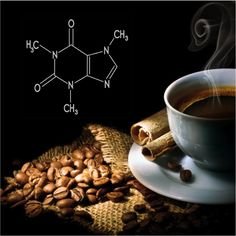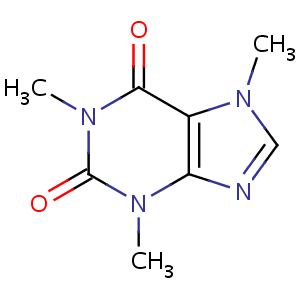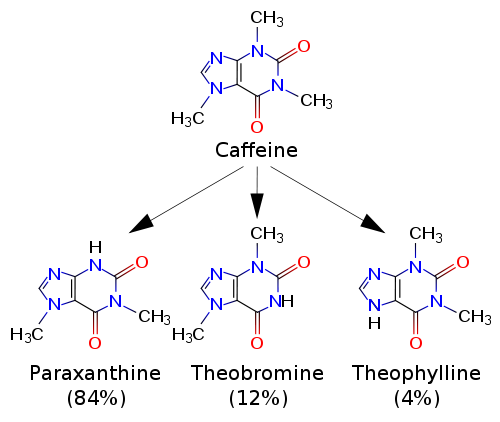The Chemistry of the Coffee
We know that we love it, that its effects help us to be more alert and focused, it is the extra dose of energy that we sometimes need, and also its flavor captivates us. Coffee is tempting for many reasons, and chemistry has answers to several of them.

Source
One of the most well-known and used effects of coffee is that it helps to avoid the sensation of sleep, especially in the morning when we still feel numb. Is that at that time, we still have in our body a significant amount of melatonin, which is the hormone that controls the circadian cycle and induces sleep, is the one that begins to increase as we feel sleepy. Coffee allows us to eliminate melatonin faster from our system and still feel active.
But in addition, coffee gives us a delicious taste and an irresistible aroma, which is also the effect of a complex process that goes from the planting and harvesting of green beans, to the preparation and subsequent ingestion and metabolization in our body.
The chemical composition of coffee and its effect on flavor and aroma.
Quality coffee is healthy, has a pleasant flavor, is innocuous and its aroma is very characteristic. In addition, its natural composition makes it a beverage with a high chemical value and difficult to imitate.
But do we know all the substances that make up coffee and its effect on this beverage?
We are going to review the essential components of coffee and its influence on key factors such as taste, aroma, body or whether it is a bitter coffee or not:
- Polysaccharides: They are responsible for retaining the aroma of coffee, contribute to form the body of the drink as well as the foam.
- Reducing sugars: They influence flavor, color, and aroma.
- Proteins: They contribute to the taste, and to the degree of bitter, as well as to the consistency of the foam.
- Sucrose: Has a direct influence on whether coffee is bitter or not, color, acidity and even aroma.
- Lipids: Lipids are responsible for the transport of flavor and aroma, as well as enhancing the flavor and body.
- Trigonelline: It is a component that affects the degree of bitterness.
- Caffeine: Depending on the amount the coffee will be more bitter or less.
- Aliphatic acids: This substance affects the acidity, arom, and body in equal parts.
- Chlorogenic acids: gives body to coffee, enhances the bitter taste and the astringency of the drink.

Source
The type of chemical compounds of coffee flavor and aroma depend on the species being grown, maturity, drying and fermentation conditions, the method by which the grain is stored, the degree of roasting to which it is subjected and the preparation process in general.
When there are so many factors that influence the final result of coffee, there is a current of fans of this drink that are dedicated to cultivate the different types that exist, and to experiment in different areas of the world, in order to perfect the process of creation and cultivation of one of the most important drinks in the world.
Chemical composition of natural Arabica coffee in grams per 100 gr:
Cellulose ................................................... 28,75
Water ......................................................... 11,24
Oily substances ......................................... 13,63
Proteins (including caffeine) .................... 15,74
Caffeine ....................................................... 1,16
Non-greasy extract ................................... 25,02
Pentosa and ashes ..................................... 4,46
Continuing with the chemistry of coffee in the brain, we must consider that caffeine is a molecule similar to adenosine, a brain substance that has a protective effect, by decreasing its activity when we are tired. Because of its similarity, caffeine manages to insert itself into the adenosine receptors, blocking it by eliminating the feeling of fatigue, but also evading brain protection. That is why we feel active and alert, but if we deprive ourselves of adenosine permanently, the effects can be harmful.
At the digestive level, caffeine is broken down in the liver into three different molecules, such as paraxanthin, theobromine , and theophylline. Paraxanthine improves athletic performance by sending fat to the muscles as an energy source. Theobromine increases the levels of oxygen and nutrients in the brain. And theophylline increases the heart rate, the force of contraction of the heart.

Source
For all these reasons, caffeine offers its energetic effect, while coffee delights us with its flavor, aroma and texture. Chemistry explains all these phenomena, although coffee for many, is not explained: be a passion.
For more information visit the following links
https://gobean.com
https://www.pinterest.com
http://itech.dickinson.edu
https://ftcoffee.wordpress.com
I hope you liked it, and that it will be useful, thank you for your time, do not forget to comment and, if you liked, vote and follow me for more material like this. @robertoromero
Thanks, I will continue to publish quality content, with relevance that fits my environment.
Thanks for this educational post
Thanks for reading
your post is very complete @robertoromero explains the coffee chemistry very detailed, I love coffee but I had no idea of any of this, very good post!
Thank you for reading it, if it is a unique drink, and without wanting it also has its composition !!!
Awesome!... Now I want some coffee.